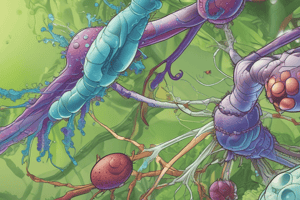Podcast
Questions and Answers
What is the main difference between thigmotropism and nastic movement?
What is the main difference between thigmotropism and nastic movement?
- Thigmotropism is a response to temperature, while nastic movement is a response to water
- Thigmotropism is a directional response, while nastic movement is a non-directional response (correct)
- Thigmotropism is a response to light, while nastic movement is a response to touch
- Thigmotropism is a response to chemicals, while nastic movement is a response to electricity
What type of tropism is exhibited by roots growing towards higher relative humidity?
What type of tropism is exhibited by roots growing towards higher relative humidity?
- Gravitropism
- Phototropism
- Hydrotropism (correct)
- Thigmotropism
What is the difference between heliotropism and phototropism?
What is the difference between heliotropism and phototropism?
- Heliotropism is a response to any light, while phototropism is a response to sunlight (correct)
- Heliotropism is a response to sunlight, while phototropism is a response to any light
- Heliotropism is a response to water, while phototropism is a response to light
- Heliotropism is a response to temperature, while phototropism is a response to light
What type of tropism is exhibited by an organism responding to temperature changes?
What type of tropism is exhibited by an organism responding to temperature changes?
Which of the following is an example of positive thigmotropism?
Which of the following is an example of positive thigmotropism?
What type of tropism is exhibited by an organism responding to an electric field?
What type of tropism is exhibited by an organism responding to an electric field?
Which of the following is not an example of tropism?
Which of the following is not an example of tropism?
What is the direction of diatropic movements?
What is the direction of diatropic movements?
Which type of tropism has the most influence on root growth?
Which type of tropism has the most influence on root growth?
What is the response of roots when they come into contact with an object like a rock?
What is the response of roots when they come into contact with an object like a rock?
Flashcards are hidden until you start studying
Study Notes
The Meaning of Tropism
- The word "tropism" originates from the Greek word "tropos," meaning a turning.
- Tropism is the ability of an organism to respond to a stimulus by turning from one direction to another.
- It can be positive or negative, depending on the kind and source of stimulation.
Tropism in Plants
- Tropism in plants is a growth-mediated movement response to an external stimulus.
- It is different from taxis and kinesis, which involve movement responses to a stimulus.
- Tropism is directional specific and occurs due to the asymmetrical elongation of cells on either side of the responding organ.
Types of Tropism in Plants
- Phototropism: growth or movement of an organism toward light (positive) or away from light (negative/scototropism).
- Chemotropism: growth in response to chemicals, such as roots growing toward minerals or away from harmful acids.
- Geotropism (Gravitropism): growth in response to gravity, with roots growing toward the gravitational field and stems growing away from it.
- Thigmotropism: response to touch, with positive thigmotropism involving growth toward a stimulus and negative thigmotropism involving growth away from it.
- Hydrotropism: growth in response to water or moisture, with positive hydrotropism involving growth toward water and negative hydrotropism involving growth away from water.
Other Plant Tropisms
- Heliotropism: growth in response to sunlight, with positive heliotropism involving growth toward sunlight and negative heliotropism involving growth away from sunlight.
- Thermotropism: growth in response to temperature changes.
- Electrotropism: growth in response to an electric field.
Auxin and Directional Growth
- Auxin plays a major role in growth-mediated plant movements, promoting or inhibiting cell elongation.
- Auxin is produced at the apical region of the shoot and is carried to other plant parts through auxin carrier proteins.
- Auxin-binding protein and co-receptors initiate a signal transduction pathway that controls the expression of genes involved in cell wall loosening and extensibility.
Studying That Suits You
Use AI to generate personalized quizzes and flashcards to suit your learning preferences.




